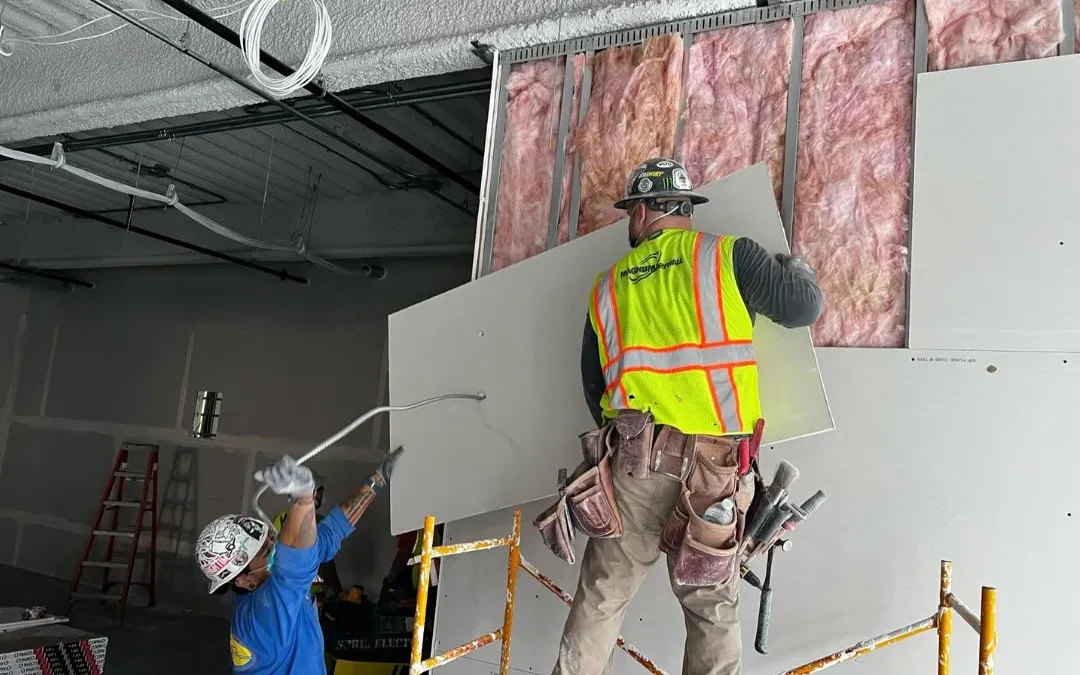Drywall Installment Made Easy: Tips for Perfect Outcomes
Drywall setup is often viewed as an overwhelming task, yet with the appropriate method and expertise, it can come to be a manageable venture. Selecting quality materials and preparing the installation area are crucial very first steps that establish the structure for success. Understanding methods for reducing, hanging, and completing drywall can significantly influence the result. As we check out these necessary ideas, you might find that even the smallest changes in your strategy can cause extremely boosted results, leaving you to take into consideration just how these methods can change your following project.
Selecting the Right Materials
Choosing the ideal products for drywall setup is vital to achieving a sturdy and visually pleasing surface. sheetrock repair fort worth. The primary part, drywall sheets, normally can be found in different thicknesses, with 1/2-inch sheets being standard for interior walls. For areas needing additional dampness resistance, such as kitchen areas or shower rooms, consider making use of environment-friendly board or cement board, which are specially made to stand up to moisture

Furthermore, picking the appropriate bolts-- either screws or nails-- is essential for securing the drywall to the framing. Drywall screws are usually preferred for their holding power and reduced danger of popping. Consider the finishing touches such as primer and paint, which not only boost the look however also safeguard the drywall from dampness and wear.
Preparing the Installation Area
Prior to starting the drywall setup process, it is important to prepare the setup area thoroughly. This prep work includes several crucial steps to make sure a successful and smooth job. First, clear the area of any kind of furnishings, devices, or blockages that can prevent accessibility. A clean work space decreases the threat of damages to existing items and permits efficient activity during installation.
Next, check the walls and ceiling for any kind of flaws, such as splits, openings, or mold and mildew. Address these problems beforehand; spot any problems and permit enough time for repair work to completely dry. Additionally, guarantee that electrical outlets, switches, and plumbing are correctly positioned and represented, as this will certainly affect drywall positioning.
Take into consideration the ecological problems as well. A secure temperature level and humidity level are essential for optimal attachment and efficiency of the drywall products. Use a dehumidifier or heating unit to produce suitable conditions. if required.
Cutting and Hanging Drywall
The key to effective drywall installment lies in the accurate cutting and hanging of the panels. Use a straight edge and an energy knife to score the drywall along your measurements, then snap it along the racked up my latest blog post line for a clean break.

Always work from the top down and delegated right, ensuring that you preserve a staggered pattern to boost security. Correctly hanging the drywall sets the structure for a smooth surface, ultimately causing superior lead to your drywall project.
Taping and Mudding Strategies
While correct cutting and dangling of drywall sets the stage, the following essential action involves mastering taping and mudding strategies to guarantee a smooth finish. Taping is crucial for reinforcing joints and avoiding splits; it entails installing tape into the used joint compound (mud) Start with a quality fiberglass or paper tape, using the tape over the joint and pushing it right into the wet mud utilizing a taping knife, guaranteeing no air bubbles stay.
As soon as the tape remains in location, apply a thin layer of joint substance over the tape, feathering the edges to develop a smooth change to the drywall surface. Allow this layer to dry completely prior to sanding it lightly to remove blemishes. Repeat this process, using additional coats of mud as necessary-- commonly a couple of coats-- while gradually broadening the application area with each layer to attain a smooth look.
After the last coat dries out, sand the surface with a fine-grit sandpaper until smooth. drywall installation. Keep in mind to put on a mask throughout fining sand to prevent breathing in dirt particles. Mastering these taping and mudding methods is critical for attaining a professional-quality surface in your drywall installment
Completing Touches for Excellence
Accomplishing a remarkable drywall installment goes past mudding and taping; it finishes in the ending up touches that elevate the total appearance. These last steps are crucial in ensuring a professional-grade coating that boosts the appearances of your space.
Begin by sanding the dried out joint substance to produce a smooth surface. sheetrock repair fort worth. After fining sand, clean down the walls with a moist towel to get rid of any dirt bits, making sure a tidy surface area for paint.
Next, apply a primer particularly developed for drywall. This step is necessary, as it assists seal the joint compound and gives an uniform base for the topcoat. Once the primer dries out, check for any type of blemishes, and touch up as needed.
Conclusion
Finally, successful drywall setup pivots on the mindful choice of products, complete preparation of the installation area, and accurate visite site implementation of cutting and hanging techniques. Mastery of taping and mudding procedures is vital for achieving a smooth coating. Furthermore, focus to pop over to these guys completing touches, including priming and touch-ups, ensures a professional-grade outcome. By sticking to these standards, the quality of craftsmanship can be substantially improved, contributing to the general visual and capability of the room.
Drywall installment is typically regarded as a daunting task, yet with the ideal approach and expertise, it can come to be a workable undertaking.Selecting the suitable materials for drywall installation is crucial to accomplishing a resilient and visually pleasing surface.Prior to starting the drywall installment procedure, it is necessary to prepare the installment area extensively. Mastering these taping and mudding methods is vital for attaining a professional-quality finish in your drywall setup.
In verdict, successful drywall setup pivots on the mindful selection of materials, complete preparation of the installment location, and accurate implementation of reducing and hanging strategies.